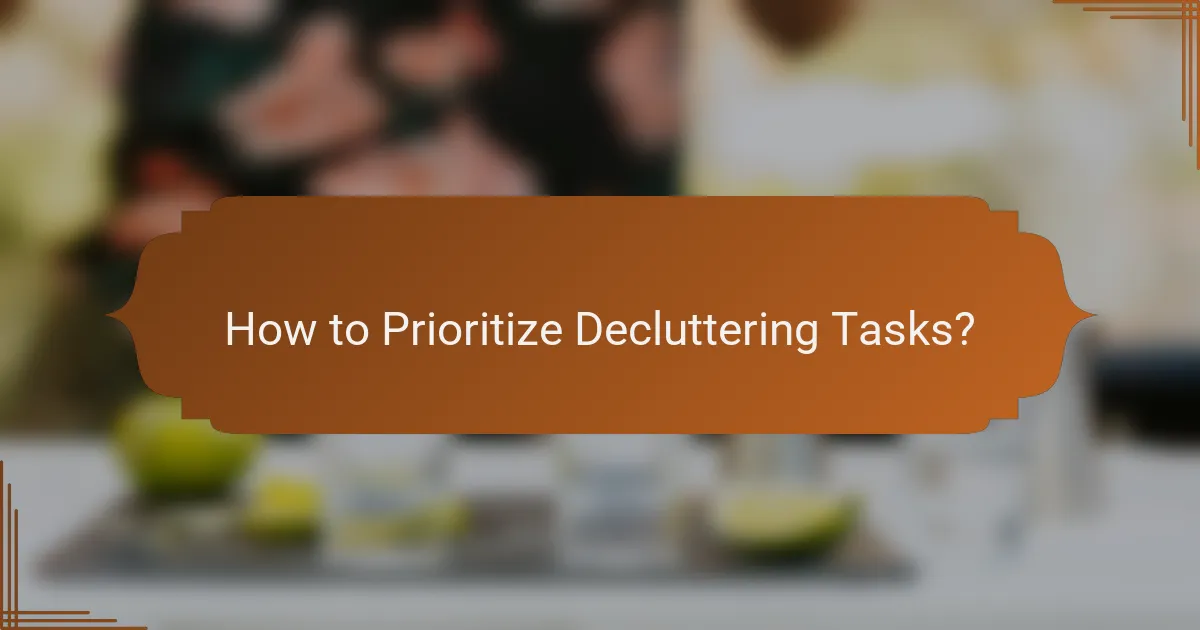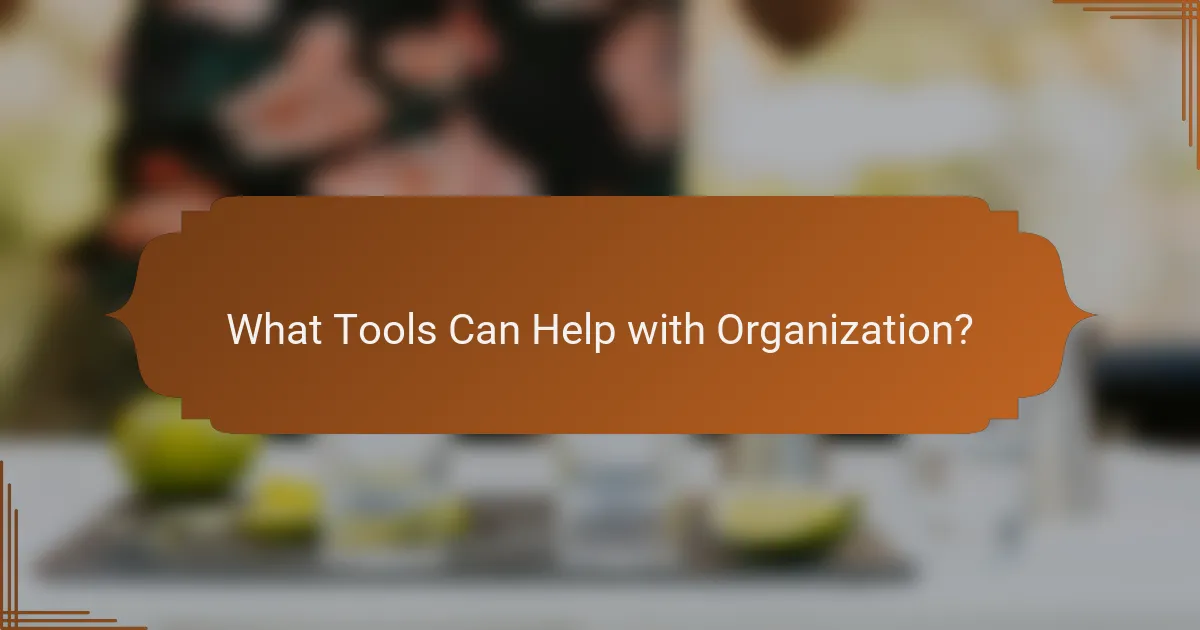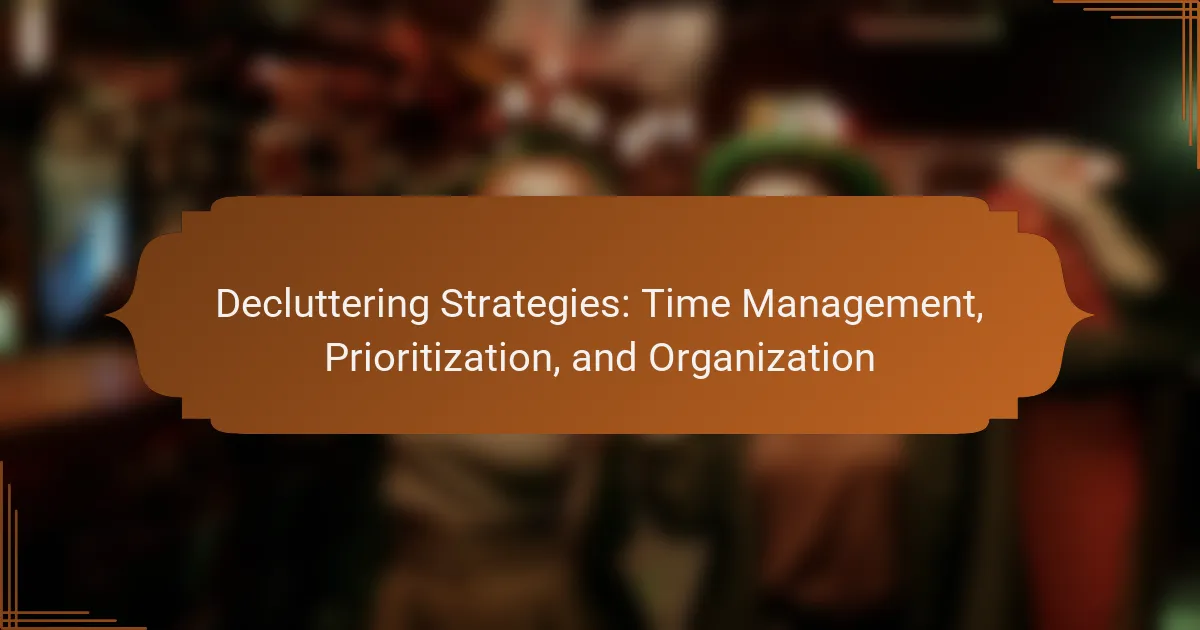Decluttering your space can significantly enhance your mental clarity and overall well-being. By mastering time management, prioritizing impactful tasks, and utilizing effective organization tools, you can transform your environment into a more functional and serene space. Implementing these strategies will not only simplify the decluttering process but also help maintain an organized lifestyle long-term.

What Are Effective Decluttering Strategies?
Effective decluttering strategies focus on managing your time, prioritizing tasks, and organizing your space efficiently. By implementing structured methods, you can streamline the decluttering process and create a more organized environment.
Time blocking for tasks
Time blocking involves scheduling specific periods for decluttering tasks within your calendar. By allocating dedicated time slots, you can focus on one area at a time without distractions. For example, set aside 30 minutes each day to tackle a particular room or category of items.
To maximize effectiveness, ensure that your time blocks are realistic and fit into your daily routine. Avoid overcommitting; instead, start with shorter sessions and gradually increase the duration as you become more comfortable with the process.
Using the Pomodoro Technique
The Pomodoro Technique is a time management method that encourages focused work sessions followed by short breaks. Typically, you work for 25 minutes, then take a 5-minute break. This approach can help maintain your energy and focus during decluttering tasks.
To implement this technique, set a timer for 25 minutes and concentrate solely on decluttering during that time. After the timer goes off, take a brief break to recharge before starting another session. This can help prevent burnout and keep your motivation high.
Creating a decluttering checklist
A decluttering checklist serves as a roadmap for your organizing efforts. It can help you stay focused and ensure that you address all areas that need attention. Start by listing specific tasks, such as sorting through clothes, clearing out kitchen cabinets, or organizing paperwork.
As you complete each task, check it off your list. This not only provides a sense of accomplishment but also helps you track your progress. Consider breaking larger tasks into smaller, manageable steps to make the process less overwhelming.
Implementing the 80/20 rule
The 80/20 rule, or Pareto Principle, suggests that 80% of your results come from 20% of your efforts. In decluttering, this means that a small portion of your belongings likely contributes to most of the clutter. Focus on identifying and addressing these key items first.
To apply this rule, evaluate your possessions and determine which items you use most frequently. Prioritize decluttering those areas where you see the most clutter accumulation. This targeted approach can lead to significant improvements in your space with less effort.

How to Prioritize Decluttering Tasks?
To prioritize decluttering tasks effectively, focus on areas that will yield the most significant impact on your space and mental clarity. This involves assessing which spaces or items contribute most to clutter and addressing them first.
Identifying high-impact areas
Start by evaluating your home or workspace to identify high-impact areas. These are typically spaces that are frequently used or contribute significantly to your overall sense of disorder, such as living rooms, kitchens, or home offices.
Make a list of these areas and rank them based on how cluttered they feel and how often they affect your daily life. For example, if your kitchen counter is often cluttered with mail and dishes, prioritize it over less-used spaces like guest rooms.
Using the Eisenhower Matrix
The Eisenhower Matrix is a useful tool for prioritizing decluttering tasks based on urgency and importance. Divide your tasks into four quadrants: urgent and important, important but not urgent, urgent but not important, and neither urgent nor important.
Focus first on tasks that fall into the “urgent and important” category, as these will provide immediate relief. For instance, clearing out a cluttered entryway can make a significant difference in your daily routine.
Setting deadlines for each task
Assigning deadlines to each decluttering task can help maintain momentum and accountability. Break down larger tasks into smaller, manageable steps and set specific time frames for each.
For example, allocate one hour to declutter your desk and another hour for organizing your closet. Stick to these deadlines to avoid procrastination and ensure steady progress.

What Tools Can Help with Organization?
Effective organization can be greatly enhanced by utilizing various tools designed to streamline processes and improve efficiency. These tools can range from digital applications to physical storage solutions, each serving a unique purpose in decluttering and managing your space.
Using digital organization apps
Digital organization apps can significantly aid in keeping your tasks and projects in order. Applications like Trello, Todoist, and Evernote allow users to create to-do lists, set reminders, and manage projects visually. Many of these apps offer features such as collaboration tools and cloud storage, making them ideal for both personal and professional use.
When selecting an app, consider factors like user interface, compatibility with other tools, and pricing. Many apps offer free versions with basic features, while premium subscriptions unlock advanced functionalities. Aim for an app that fits your specific organizational needs and preferences.
Investing in storage solutions
Physical storage solutions are essential for maintaining an organized environment. Options include shelving units, bins, and drawer organizers that help categorize and store items effectively. Investing in quality storage can reduce clutter and improve accessibility to frequently used items.
When choosing storage solutions, assess the space available and the types of items you need to store. Consider modular systems that can be adjusted as your needs change. It’s often beneficial to prioritize clear containers, as they allow for easy visibility of contents, aiding in quicker retrieval.
Employing labeling systems
Labeling systems are a practical way to enhance organization by clearly identifying the contents of storage areas. Labels can be applied to boxes, shelves, and files, making it easier to locate items quickly. Using consistent labeling formats helps maintain order and reduces the time spent searching for things.
For effective labeling, use durable materials that can withstand wear and tear. Consider color-coding labels for different categories or types of items to streamline the organization process. Regularly review and update labels as your storage needs evolve to ensure continued clarity and efficiency.

How to Maintain a Clutter-Free Space?
To maintain a clutter-free space, focus on developing consistent habits and routines that prioritize organization. Regularly assessing your environment and making small adjustments can significantly reduce clutter over time.
Establishing daily habits
Daily habits are essential for keeping your space organized. Start by dedicating a few minutes each day to tidying up, such as putting items back in their designated places or decluttering surfaces. Aim for a routine that fits easily into your schedule, like a quick clean-up before bed or after meals.
Consider using a checklist to track your daily tasks. Simple actions, such as sorting mail immediately or setting a timer for 10 minutes to declutter a specific area, can make a big difference. Consistency is key; the more you practice these habits, the more natural they will become.
Regularly scheduled decluttering sessions
Setting aside time for regular decluttering sessions helps maintain a clutter-free environment. Aim for at least once a month to thoroughly assess your belongings and decide what to keep, donate, or discard. This proactive approach prevents clutter from accumulating and becoming overwhelming.
During these sessions, focus on specific areas, such as closets, drawers, or storage spaces. Use a simple method like the “one in, one out” rule, where for every new item you bring in, you remove an old one. This practice not only keeps your space organized but also encourages mindful consumption.

What Are the Benefits of Decluttering?
Decluttering offers numerous benefits, including improved focus and efficiency in daily tasks. By organizing your space and minimizing distractions, you can create a more conducive environment for productivity and mental well-being.
Improved mental clarity
Decluttering leads to improved mental clarity by reducing visual distractions and creating a more serene environment. When your surroundings are organized, it becomes easier to concentrate on tasks without the chaos of clutter vying for your attention.
To achieve this, start with small areas, such as a desk or a single drawer. Set aside a short time each day to sort through items, deciding what to keep, donate, or discard. This incremental approach can significantly enhance your mental space over time.
Enhanced productivity
Enhanced productivity is a direct result of decluttering, as an organized space allows for quicker access to necessary items and less time spent searching for them. When your environment is tidy, you can focus more on your work and less on managing distractions.
Consider implementing a system for organizing your workspace, such as using labeled storage bins or digital tools for task management. Regularly reassess your belongings to ensure that everything serves a purpose and contributes to your efficiency. Aim to maintain a clutter-free environment by dedicating a few minutes each week to tidying up.
